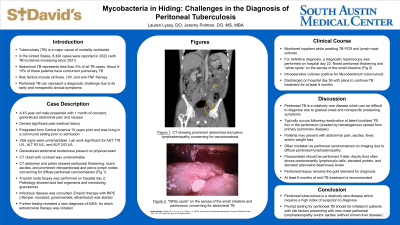Tuesday Poster Session
Category: Small Intestine
P4152 - Mycobacteria in Hiding: Challenges in the Diagnosis of Peritoneal Tuberculosis
Tuesday, October 24, 2023
10:30 AM - 4:00 PM PT
Location: Exhibit Hall

Has Audio

Lauren A. Lyssy, DO
St. David's South Austin Medical Center
Austin, TX
Presenting Author(s)
Lauren Lyssy, DO1, Jeremy Polman, DO, MS, MBA2
1St. David's South Austin Medical Center, Austin, TX; 2St. David's South Austin Medical Center, Nashville, TN
Introduction: Tuberculosis (TB) is a major cause of mortality worldwide. Peritoneal infection is a rare manifestation of TB and can represent a diagnostic challenge due to its nonspecific clinical symptoms and occurrence without active pulmonary TB. Here, we present an interesting case of peritoneal TB with initial imaging findings concerning for malignancy.
Case Description/Methods: A 45-year-old male with no significant past medical history presented with 1 month of generalized abdominal pain and nausea. He was originally from Central America and was living in a communal setting prior to admission. At presentation, vital signs were unremarkable, and no leukocytosis was present. Physical examination demonstrated generalized abdominal pain without rebound tenderness or apparent distension. CT chest was unremarkable. CT abdomen and pelvis showed peritoneal thickening, a small amount of ascites, and prominent retroperitoneal and pelvic lymph nodes concerning for diffuse peritoneal carcinomatosis. Oncology evaluated and a lymph node biopsy was performed on hospital day 2. Pathology showed acid-fast organisms and necrotizing granulomas. Infectious disease was consulted, and the patient was empirically initiated on TB treatment. Further testing revealed a new diagnosis of AIDS and antiretroviral therapy was started. The patient was closely monitored in the hospital while awaiting TB PCR and lymph node cultures. Due to worsening abdominal pain, a repeat CT abdomen was performed, with findings essentially unchanged from admission. General surgery was consulted for evaluation. A diagnostic laparoscopy was performed on hospital day 22, remarkable for peritoneal thickening and white spots on the serosa of the small intestine. Intraoperative cultures were positive for Mycobacterium tuberculosis. His abdominal pain resolved, and the patient was discharged on hospital day 36 with plans for at least 6 months of tuberculosis treatment.
Discussion: Peritoneal TB often presents with nonspecific symptoms and can be difficult to distinguish from other gastrointestinal pathology. On admission, tuberculosis was considered an unlikely diagnosis in this patient due to the lack of pulmonary involvement, normal vital signs, and imaging findings concerning for cancer. An increased awareness of peritoneal tuberculosis is needed, and appropriate testing should be promptly ordered when this diagnosis is suspected.
Disclosures:
Lauren Lyssy, DO1, Jeremy Polman, DO, MS, MBA2. P4152 - Mycobacteria in Hiding: Challenges in the Diagnosis of Peritoneal Tuberculosis, ACG 2023 Annual Scientific Meeting Abstracts. Vancouver, BC, Canada: American College of Gastroenterology.
1St. David's South Austin Medical Center, Austin, TX; 2St. David's South Austin Medical Center, Nashville, TN
Introduction: Tuberculosis (TB) is a major cause of mortality worldwide. Peritoneal infection is a rare manifestation of TB and can represent a diagnostic challenge due to its nonspecific clinical symptoms and occurrence without active pulmonary TB. Here, we present an interesting case of peritoneal TB with initial imaging findings concerning for malignancy.
Case Description/Methods: A 45-year-old male with no significant past medical history presented with 1 month of generalized abdominal pain and nausea. He was originally from Central America and was living in a communal setting prior to admission. At presentation, vital signs were unremarkable, and no leukocytosis was present. Physical examination demonstrated generalized abdominal pain without rebound tenderness or apparent distension. CT chest was unremarkable. CT abdomen and pelvis showed peritoneal thickening, a small amount of ascites, and prominent retroperitoneal and pelvic lymph nodes concerning for diffuse peritoneal carcinomatosis. Oncology evaluated and a lymph node biopsy was performed on hospital day 2. Pathology showed acid-fast organisms and necrotizing granulomas. Infectious disease was consulted, and the patient was empirically initiated on TB treatment. Further testing revealed a new diagnosis of AIDS and antiretroviral therapy was started. The patient was closely monitored in the hospital while awaiting TB PCR and lymph node cultures. Due to worsening abdominal pain, a repeat CT abdomen was performed, with findings essentially unchanged from admission. General surgery was consulted for evaluation. A diagnostic laparoscopy was performed on hospital day 22, remarkable for peritoneal thickening and white spots on the serosa of the small intestine. Intraoperative cultures were positive for Mycobacterium tuberculosis. His abdominal pain resolved, and the patient was discharged on hospital day 36 with plans for at least 6 months of tuberculosis treatment.
Discussion: Peritoneal TB often presents with nonspecific symptoms and can be difficult to distinguish from other gastrointestinal pathology. On admission, tuberculosis was considered an unlikely diagnosis in this patient due to the lack of pulmonary involvement, normal vital signs, and imaging findings concerning for cancer. An increased awareness of peritoneal tuberculosis is needed, and appropriate testing should be promptly ordered when this diagnosis is suspected.
Disclosures:
Lauren Lyssy indicated no relevant financial relationships.
Jeremy Polman indicated no relevant financial relationships.
Lauren Lyssy, DO1, Jeremy Polman, DO, MS, MBA2. P4152 - Mycobacteria in Hiding: Challenges in the Diagnosis of Peritoneal Tuberculosis, ACG 2023 Annual Scientific Meeting Abstracts. Vancouver, BC, Canada: American College of Gastroenterology.
